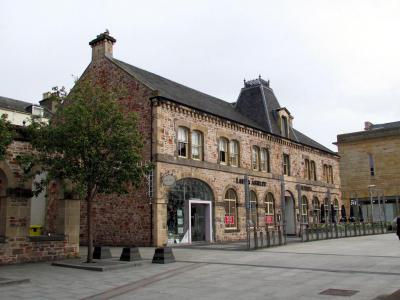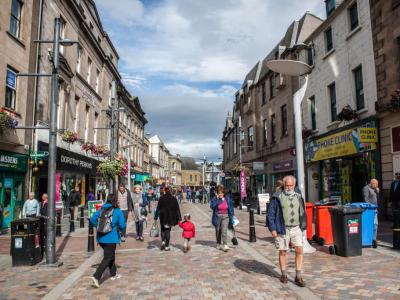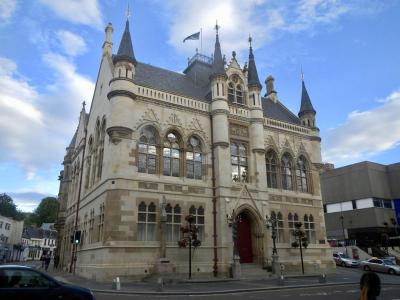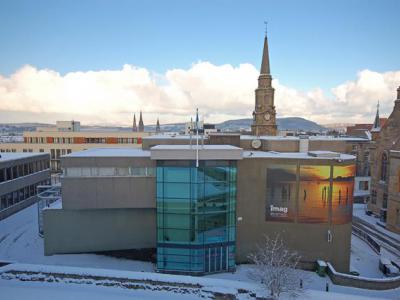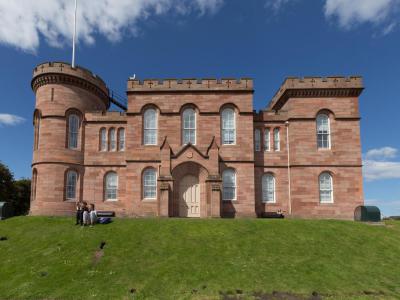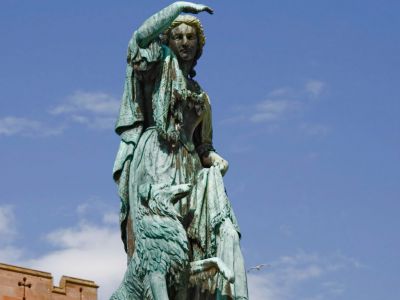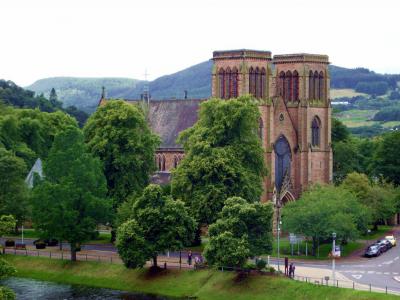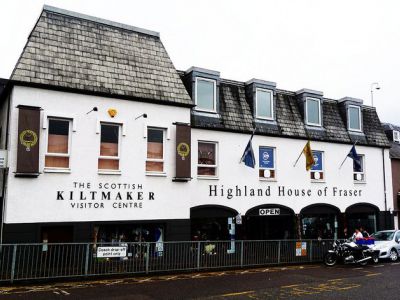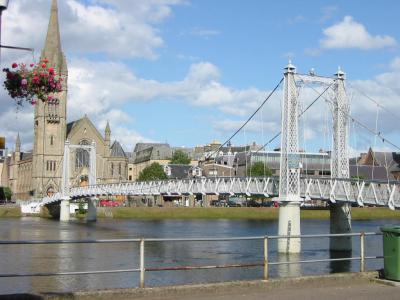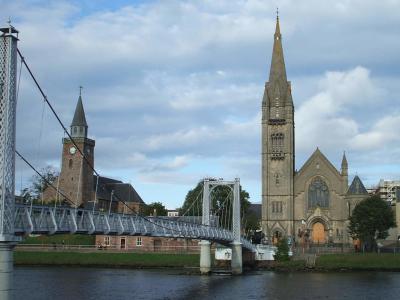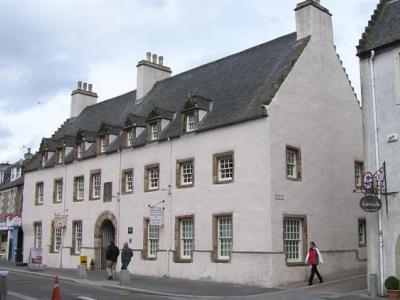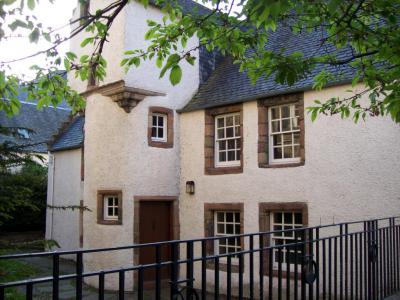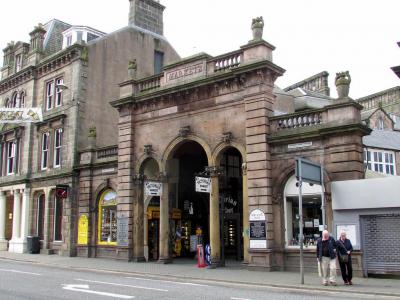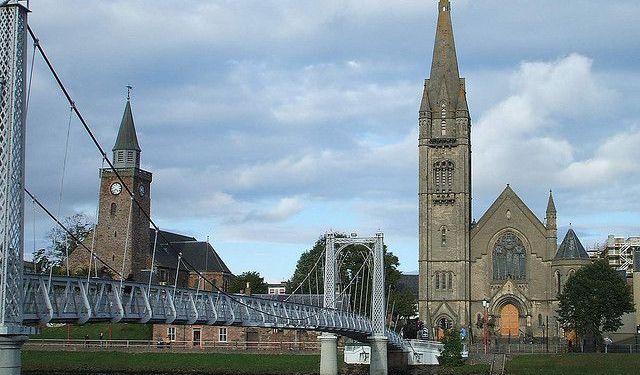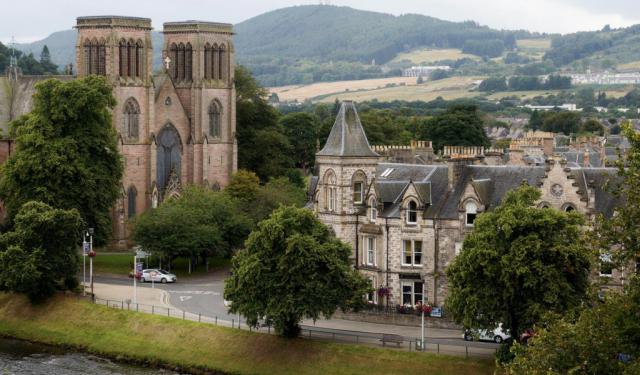
Inverness Introduction Walking Tour (Self Guided), Inverness
Often regarded as the Capital of the Scottish Highlands, Inverness is steeped in history and legend. The name "Inverness" derives from the Scottish Gaelic "Inbhir Nis," which means "mouth of the River Ness," a fitting moniker for a city that thrives along the banks of this scenic waterway.
The Inverness area has been inhabited since 6500 BC, once being a significant stronghold of the Pict people. Following a visit by Saint Columba in 569 AD, the early Celtic monks established their presence on Saint Michael's Mount, now the site of the Old High Church.
Much of Inverness's history is associated with its Medieval past. William Shakespeare immortalized the town in his play "Macbeth" based on the 11th-century murder of King Duncan. Although the play was pure fiction and the castle where the real MacBeth lived no longer stands, the story did stand the test of time. Visitors can now walk the grounds of the rebuilt Inverness Castle believing here MacBeth set his foot on.
Inverness saw its first royal charter granted in the 12th century. The strategic importance of its location led to numerous conflicts, including battles between Scottish monarchs and Norse invaders, shaping its tumultuous past until the 15th century.
During the 1562 suppression of Huntly's insurrection, Mary, Queen of Scots, was refused entry to Inverness Castle by the governor, which led to his subsequent execution and the castle itself being seized on her behalf. Later, Inverness saw Oliver Cromwell's construction of a citadel, which played a significant part in the Jacobite rising of 1689, but was demolished after the restoration of the British monarchy.
In the 18th century, Inverness witnessed turbulent times once again as Jacobites raised another revolt in 1745. Visitors can learn more about this period of Scottish history by touring the Inverness Museum and Art Gallery or checking out the Flora McDonald Statue.
More recently, in 1921, the Inverness Town House hosted the historic British Cabinet meeting, leading to the formulation of the Inverness Formula, pivotal in the Anglo-Irish Treaty which concluded the Irish War of Independence.
In modern times, Inverness has seen remarkable economic growth and been consistently acclaimed as one of Scotland's happiest places. As you stroll through the bustling thoroughfares of Falcon Square and High Street, the echoes of centuries past will reverberate through the cobblestone streets and linger in your memory long after you've departed. So, to hear more clearly the stories they tell, follow this self-guided walking tour.
The Inverness area has been inhabited since 6500 BC, once being a significant stronghold of the Pict people. Following a visit by Saint Columba in 569 AD, the early Celtic monks established their presence on Saint Michael's Mount, now the site of the Old High Church.
Much of Inverness's history is associated with its Medieval past. William Shakespeare immortalized the town in his play "Macbeth" based on the 11th-century murder of King Duncan. Although the play was pure fiction and the castle where the real MacBeth lived no longer stands, the story did stand the test of time. Visitors can now walk the grounds of the rebuilt Inverness Castle believing here MacBeth set his foot on.
Inverness saw its first royal charter granted in the 12th century. The strategic importance of its location led to numerous conflicts, including battles between Scottish monarchs and Norse invaders, shaping its tumultuous past until the 15th century.
During the 1562 suppression of Huntly's insurrection, Mary, Queen of Scots, was refused entry to Inverness Castle by the governor, which led to his subsequent execution and the castle itself being seized on her behalf. Later, Inverness saw Oliver Cromwell's construction of a citadel, which played a significant part in the Jacobite rising of 1689, but was demolished after the restoration of the British monarchy.
In the 18th century, Inverness witnessed turbulent times once again as Jacobites raised another revolt in 1745. Visitors can learn more about this period of Scottish history by touring the Inverness Museum and Art Gallery or checking out the Flora McDonald Statue.
More recently, in 1921, the Inverness Town House hosted the historic British Cabinet meeting, leading to the formulation of the Inverness Formula, pivotal in the Anglo-Irish Treaty which concluded the Irish War of Independence.
In modern times, Inverness has seen remarkable economic growth and been consistently acclaimed as one of Scotland's happiest places. As you stroll through the bustling thoroughfares of Falcon Square and High Street, the echoes of centuries past will reverberate through the cobblestone streets and linger in your memory long after you've departed. So, to hear more clearly the stories they tell, follow this self-guided walking tour.
How it works: Download the app "GPSmyCity: Walks in 1K+ Cities" from Apple App Store or Google Play Store to your mobile phone or tablet. The app turns your mobile device into a personal tour guide and its built-in GPS navigation functions guide you from one tour stop to next. The app works offline, so no data plan is needed when traveling abroad.
Inverness Introduction Walking Tour Map
Guide Name: Inverness Introduction Walking Tour
Guide Location: Scotland » Inverness (See other walking tours in Inverness)
Guide Type: Self-guided Walking Tour (Sightseeing)
# of Attractions: 13
Tour Duration: 2 Hour(s)
Travel Distance: 2.3 Km or 1.4 Miles
Author: leticia
Sight(s) Featured in This Guide:
Guide Location: Scotland » Inverness (See other walking tours in Inverness)
Guide Type: Self-guided Walking Tour (Sightseeing)
# of Attractions: 13
Tour Duration: 2 Hour(s)
Travel Distance: 2.3 Km or 1.4 Miles
Author: leticia
Sight(s) Featured in This Guide:
- Falcon Square
- High Street
- Inverness Town House
- Inverness Museum and Art Gallery
- Inverness Castle
- Flora McDonald Statue
- Inverness Cathedral
- Highland House of Fraser
- Greig Street Bridge
- Free North Church
- Dunbar's Hospital
- Abertarff House
- Victorian Market
1) Falcon Square
Falcon Square is a city square in the center of Inverness. It was named for John Falconer who was the founder of the Falcon Foundry in 1858. The foundry was originally located next to the Inverness Railway Station but it was taken apart and rebuilt in Falcon Square in the late 1990s. Falcon Foundry is now enjoyed by tourists and locals who wish to shop and dine in the historic building.
In the midst of Falcon Square is a 37-foot sandstone pillar. It is topped by a bronze unicorn and a soaring falcon. The monument was designed by sculptor Gerald Laing and it was unveiled in 2003.
There are a wide variety of shops and dining establishments available at Falcon Square. Those who want a taste of home can find numerous chain restaurants. Visitors who want to spend the day shopping in a comfortable environment will enjoy their time at the shopping center. It is also a good place to rest, relax and people watch.
In the midst of Falcon Square is a 37-foot sandstone pillar. It is topped by a bronze unicorn and a soaring falcon. The monument was designed by sculptor Gerald Laing and it was unveiled in 2003.
There are a wide variety of shops and dining establishments available at Falcon Square. Those who want a taste of home can find numerous chain restaurants. Visitors who want to spend the day shopping in a comfortable environment will enjoy their time at the shopping center. It is also a good place to rest, relax and people watch.
2) High Street
High Street is the main shopping street in Inverness. High Street stretches east to west from Eastgate to Broad Street. This street is open to foot-traffic in order to provide shoppers with a safe, carefree experience.
High Street is comprised mostly of local, Scottish boutiques with a few larger retailers like Top Shop, Lush and WH Smith that are located here. Smaller boutiques sell items that are perfect as souvenirs. Card shops, clothing, shoes and jewelry are just some of the items a shopper will find along High Street.
There are also a number of places to eat on High Street. Try traditional Scottish food or look for fast food chains that provide a sense of home.
There are many interesting places to visit near High Street. Some of these include the Culloden Battlefield, the Caledonian Canal, Cawdor Castle and Clava Cairns. A large mall, Eastgate Shopping Centre, is only steps away from High Street. The mall provides even more shopping and dining options.
High Street is comprised mostly of local, Scottish boutiques with a few larger retailers like Top Shop, Lush and WH Smith that are located here. Smaller boutiques sell items that are perfect as souvenirs. Card shops, clothing, shoes and jewelry are just some of the items a shopper will find along High Street.
There are also a number of places to eat on High Street. Try traditional Scottish food or look for fast food chains that provide a sense of home.
There are many interesting places to visit near High Street. Some of these include the Culloden Battlefield, the Caledonian Canal, Cawdor Castle and Clava Cairns. A large mall, Eastgate Shopping Centre, is only steps away from High Street. The mall provides even more shopping and dining options.
3) Inverness Town House
Inverness Town House is a municipal building located on High Street between Castle Street and Castle Wynd. The Gothic-style building was designed by architect William Lawrie in 1882. The house was built to replace the very first town house in Inverness, which was built in 1708 and demolished 150 years later.
The house was modeled on the McManus, a museum and art gallery that was designed by George Gilbert Scott. A burgh coat of arms, recovered from a bridge that crossed the River Ness, is embedded in the ashlar stone from which the townhouse is comprised. That coat of arms dates to 1685 when the bridge was completed.
An update on the town house took place in 1898 when William Meikle & Sons installed stained glass windows to celebrate Queen Victoria's Diamond Jubilee. The building was also extended in 1907. It did not undergo a major refurbishment again until 2018.
The Inverness Town House is known for containing a large number of works of art. Those who wish to see the inside of the town house should try to schedule a tour in advance. These tours take place on Thursdays at 2 PM and 3:30 PM.
The house was modeled on the McManus, a museum and art gallery that was designed by George Gilbert Scott. A burgh coat of arms, recovered from a bridge that crossed the River Ness, is embedded in the ashlar stone from which the townhouse is comprised. That coat of arms dates to 1685 when the bridge was completed.
An update on the town house took place in 1898 when William Meikle & Sons installed stained glass windows to celebrate Queen Victoria's Diamond Jubilee. The building was also extended in 1907. It did not undergo a major refurbishment again until 2018.
The Inverness Town House is known for containing a large number of works of art. Those who wish to see the inside of the town house should try to schedule a tour in advance. These tours take place on Thursdays at 2 PM and 3:30 PM.
4) Inverness Museum and Art Gallery (must see)
The Inverness Museum and Art Gallery is a contemporary gallery that features art, archaeology and natural history exhibits. The museum has been in continuous operation since 1881.
The first museum opened in 1881. It contained artwork that was created by Alexander Nasmyth, John Quinton Pringle and Tom Scott. It also featured a group of portraits that belonged to Prince Frederick Duleep Singh. These were primarily Stuart portraits, including one of Prince Charles Edward Stuart painted by Pompeo Batoni.
The current building was developed in 1963 to allow for more room for exhibits, learning and a museum cafe. The museum has samples of Scottish geology, Pictish stones, Jacobite memorabilia, Inverness silver and Highland weapons. The museum also has a vast photo archive and art gallery.
The museum is open throughout the year. Winter hours, from November to March, it is open from noon to 4 PM on Tuesday through Thursday and 11 AM to 4 PM on Friday and Saturday. The museum is open the remainder of the year from 10 AM to 12 PM on Tuesday through Saturday. Admission to the Inverness Museum and Art Gallery is free.
The first museum opened in 1881. It contained artwork that was created by Alexander Nasmyth, John Quinton Pringle and Tom Scott. It also featured a group of portraits that belonged to Prince Frederick Duleep Singh. These were primarily Stuart portraits, including one of Prince Charles Edward Stuart painted by Pompeo Batoni.
The current building was developed in 1963 to allow for more room for exhibits, learning and a museum cafe. The museum has samples of Scottish geology, Pictish stones, Jacobite memorabilia, Inverness silver and Highland weapons. The museum also has a vast photo archive and art gallery.
The museum is open throughout the year. Winter hours, from November to March, it is open from noon to 4 PM on Tuesday through Thursday and 11 AM to 4 PM on Friday and Saturday. The museum is open the remainder of the year from 10 AM to 12 PM on Tuesday through Saturday. Admission to the Inverness Museum and Art Gallery is free.
5) Inverness Castle (must see)
Inverness Castle is a 19th century, red sandstone castle that rests on the bank of the River Ness. It is the latest castle built on a site that has held a number of structures over the years. The earliest castle was built in 1057 by Malcolm III of Scotland.
The current structure was designed by a series of architects who made plans for different areas of the castle. William Burn designed the Sheriff Court. Joseph Mitchell designed the enclosing walls. Thomas Brown II designed the prison, which was later renamed to the District Court.
Visitors to Inverness will have an excellent view of the castle by walking along Castle Road next to the River Ness. Visitors may enter the north tower, but the remainder of the castle is not open for public tours.
The current structure was designed by a series of architects who made plans for different areas of the castle. William Burn designed the Sheriff Court. Joseph Mitchell designed the enclosing walls. Thomas Brown II designed the prison, which was later renamed to the District Court.
Visitors to Inverness will have an excellent view of the castle by walking along Castle Road next to the River Ness. Visitors may enter the north tower, but the remainder of the castle is not open for public tours.
6) Flora McDonald Statue
The Flora McDonald Statue is a historical landmark located near Inverness Castle. The Flora McDonald Statue is a monument to Flora McDonald who helped Prince Charles Edward Stuart evade capture by government troops after the Battle of Culloden in April 1746. She disguised the prince as her handmaiden while escaping on a boat to Skye, an island west of Inverness.
She was arrested for helping Prince Charles Edward Stuart escape and held in the Tower of London but released under a general amnesty in June 1747. She later married Allan MacDonald and the couple emigrated to North Carolina in 1773. Their support for the British government during the American War of Independence meant the loss of their American estates and they returned to Scotland, where Flora died in 1790.
The bronze statue was designed by Andrew Davidson. It was completed in 1899 and placed in front of Sheriff Court. She shields her eyes as she looks over the valley of the River Ness. A bronze, Scottish dog lies at the feet of the statue.
Along with the statue is a bronze plaque shaped like a shield. Written in both Gaelic and English, the plaque reads: "The preserver of Prince Charles Edward Stuart will be mentioned in history and if courage and fidelity be virtues, mentioned with honor."
She was arrested for helping Prince Charles Edward Stuart escape and held in the Tower of London but released under a general amnesty in June 1747. She later married Allan MacDonald and the couple emigrated to North Carolina in 1773. Their support for the British government during the American War of Independence meant the loss of their American estates and they returned to Scotland, where Flora died in 1790.
The bronze statue was designed by Andrew Davidson. It was completed in 1899 and placed in front of Sheriff Court. She shields her eyes as she looks over the valley of the River Ness. A bronze, Scottish dog lies at the feet of the statue.
Along with the statue is a bronze plaque shaped like a shield. Written in both Gaelic and English, the plaque reads: "The preserver of Prince Charles Edward Stuart will be mentioned in history and if courage and fidelity be virtues, mentioned with honor."
7) Inverness Cathedral (must see)
Inverness Cathedral is a Scottish Episcopal Church on the banks of the River Ness. The cathedral, also known as the Cathedral Church of Saint Andrew, is the seat of of the Bishop of Moray, Ross and Caithness. It was the first new Protestant cathedral built in Britain after the Reformation.
Inverness Cathedral was built in 1869 from a design by architect Alexander Ross. The cathedral is made from red tarradale stone and peterhead granite. The cathedral is noted for having the most northerly change-ringing church bells in the world.
The cathedral welcomes visitors throughout the year. The church doors are open from 10 AM to 4 PM daily. Likewise, the cathedral's gift shop and cafe are open every day except Christmas. A cathedral supervisor is on-hand to help with any questions.
Along with church services, Inverness Cathedral regularly hosts live music events, morning coffee and special events. Tourists are welcome to attend church services and any of the special events as they please.
Inverness Cathedral was built in 1869 from a design by architect Alexander Ross. The cathedral is made from red tarradale stone and peterhead granite. The cathedral is noted for having the most northerly change-ringing church bells in the world.
The cathedral welcomes visitors throughout the year. The church doors are open from 10 AM to 4 PM daily. Likewise, the cathedral's gift shop and cafe are open every day except Christmas. A cathedral supervisor is on-hand to help with any questions.
Along with church services, Inverness Cathedral regularly hosts live music events, morning coffee and special events. Tourists are welcome to attend church services and any of the special events as they please.
8) Highland House of Fraser
The Highland House of Fraser is a kilt shop located on Huntly Street near the banks of the River Ness. The Highland House of Fraser is a fun stop for those who are interested in the traditional garb of Scotland. It is not simply a shop but also the location of the Scottish Kiltmaker Visitor Centre.
Visitors will learn about the history and tradition of the kilt from its invention to today. They will see the kiltmaking workshop that has tartans and various costumes on display. There is also a short film that visitors can watch that has a humorous take on the history of the kilt.
Visitors to the Highland House of Fraser can speak with kiltmakers and learn about this specialized art. They can watch the making of the kilt as they learn about cutting, pleating and stitching the fabric. They will also learn the correct way to wear a kilt, which is a common question among visitors to Scotland.
Along with kilts, the Highland House of Fraser offers numerous souvenirs. Items like face masks, jewelry and ornaments are offered in the store.
Visitors will learn about the history and tradition of the kilt from its invention to today. They will see the kiltmaking workshop that has tartans and various costumes on display. There is also a short film that visitors can watch that has a humorous take on the history of the kilt.
Visitors to the Highland House of Fraser can speak with kiltmakers and learn about this specialized art. They can watch the making of the kilt as they learn about cutting, pleating and stitching the fabric. They will also learn the correct way to wear a kilt, which is a common question among visitors to Scotland.
Along with kilts, the Highland House of Fraser offers numerous souvenirs. Items like face masks, jewelry and ornaments are offered in the store.
9) Greig Street Bridge (must see)
The Greig Street Bridge is a pedestrian footbridge that crosses the River Ness. The Greig Street Bridge can be reached from Bank Street on the east side of the river or Huntly Street to the West.
The suspension bridge was completed in 1881 by civil engineer C. Manners. It is made of two side spans that are 67 feet and a central span of 201 feet. The total distance of the bridge is 335 feet long.
The bridge has warren trusses with handrails that pedestrians can use as they pass over the river. Some of the most notable features of the bridge are the ornamental towers on each side. The towers use latticework to create a unique visage that makes the bridge as attractive to view from far away as up close.
Visitors should also take note of the arches beneath the towers. Though they are functional, they also form the perfect frame for a photo on the bridge with the Free North Church in the distance.
The suspension bridge was completed in 1881 by civil engineer C. Manners. It is made of two side spans that are 67 feet and a central span of 201 feet. The total distance of the bridge is 335 feet long.
The bridge has warren trusses with handrails that pedestrians can use as they pass over the river. Some of the most notable features of the bridge are the ornamental towers on each side. The towers use latticework to create a unique visage that makes the bridge as attractive to view from far away as up close.
Visitors should also take note of the arches beneath the towers. Though they are functional, they also form the perfect frame for a photo on the bridge with the Free North Church in the distance.
10) Free North Church
The Free North Church is a historic, Protestant church in Inverness. It rests on Bank Street at the northeast bank of the River Ness. The Free North Church is located near a number of other tourist destinations in the city. Some of these include the Grieg Street Bridge, Inverness Castle and the Egypt War Memorial.
The Gothic-style church was completed in 1893 from a design by architect Alexander Ross. The grand-size of the church allows for a congregation of up to 1,300. The church offers a tower, stair-tower, gable and porch. Its octagonal spire, which reaches 170 feet, is the tallest in the city.
Visitors can explore the grounds of the Free North Church, including the historic cemetery. Those wanting to join the church during worship are welcome to be part of the congregation during the 11 AM or 5:30 PM services on Sundays.
The Gothic-style church was completed in 1893 from a design by architect Alexander Ross. The grand-size of the church allows for a congregation of up to 1,300. The church offers a tower, stair-tower, gable and porch. Its octagonal spire, which reaches 170 feet, is the tallest in the city.
Visitors can explore the grounds of the Free North Church, including the historic cemetery. Those wanting to join the church during worship are welcome to be part of the congregation during the 11 AM or 5:30 PM services on Sundays.
11) Dunbar's Hospital
Dunbar's Hospital was built in 1668 as a hospital and a home for the impoverished. The hospital has a rough-cast, harled finish and dormer windows surrounded by decorative brickwork. The arched doorway offers the same brickwork and a protective iron gate.
Above the door is a plaque that shows the coat of arms of Provost Alexander Dunbar, founder of the hospital. This plaque, with a date of 1676, is a reproduction of the original. Those who wish to see the original plate can find it at the Inverness Museum.
Dunbar's Hospital was used as a school until the Royal Academy opened in 1792. It was also, at times, divided into apartments, used for shops and as a senior citizen's center. It briefly returned to use as a hospital during the 1849 Cholera Epidemic. Today, the hospital is divided into a senior citizen's day center and a restaurant that is open on weekends from 9 AM to 4 PM.
The hospital is rumored to have been built from stone that was discarded from Oliver Cromwell's destroyed citadel.
Above the door is a plaque that shows the coat of arms of Provost Alexander Dunbar, founder of the hospital. This plaque, with a date of 1676, is a reproduction of the original. Those who wish to see the original plate can find it at the Inverness Museum.
Dunbar's Hospital was used as a school until the Royal Academy opened in 1792. It was also, at times, divided into apartments, used for shops and as a senior citizen's center. It briefly returned to use as a hospital during the 1849 Cholera Epidemic. Today, the hospital is divided into a senior citizen's day center and a restaurant that is open on weekends from 9 AM to 4 PM.
The hospital is rumored to have been built from stone that was discarded from Oliver Cromwell's destroyed citadel.
12) Abertarff House
Abertarff House is the oldest house in Inverness. It is a 2 1/2 story town house that was built in 1593. It is not known who originally owned the large home. What is known is that Clan Fraser purchased the home in 1793. Alexander Fraser was the first Fraser to live in the Abertarff House and many more would follow.
The home was purchased by the Commercial Bank of Scotland in the 1800s to be used as housing. Once it fell into disrepair, the bank gifted the property to the National Trust for Scotland. Abertarff House was restored to its current condition in 1966.
Open hours may vary. Interior tours are offered on some weekends. Friday hours are 1 PM to 7 PM. Saturday hours are 11 AM to 7 PM and Sunday hours are 11 AM to 6 PM. Those who cannot take a tour inside the house should still plan to stop by to see the beautiful, unique and historic architecture of the building.
The home was purchased by the Commercial Bank of Scotland in the 1800s to be used as housing. Once it fell into disrepair, the bank gifted the property to the National Trust for Scotland. Abertarff House was restored to its current condition in 1966.
Open hours may vary. Interior tours are offered on some weekends. Friday hours are 1 PM to 7 PM. Saturday hours are 11 AM to 7 PM and Sunday hours are 11 AM to 6 PM. Those who cannot take a tour inside the house should still plan to stop by to see the beautiful, unique and historic architecture of the building.
13) Victorian Market
Located on Academy Street, Inverness Victorian Market is a unique shopping spot in the city. The main entrance on Academy Street has three round arches. This historic market was rebuilt in 1890 and reflects the splendor of the Victorian era. It includes the Market Arcade, which stretches from Academy Street to Union Street and Queensgate. The market is covered by a marvelous Victorian cast-iron and wooden-domed roof. Here you will find 45 shops and a nice café where you can rest after finishing your shopping.
Walking Tours in Inverness, Scotland
Create Your Own Walk in Inverness
Creating your own self-guided walk in Inverness is easy and fun. Choose the city attractions that you want to see and a walk route map will be created just for you. You can even set your hotel as the start point of the walk.
Inverness Historical Buildings Walking Tour
Inverness, a city established in the 12th century, boasts an array of historical architecture reflecting its rich and often tumultuous past. Many of its centuries-old buildings are situated along the banks of the River Ness and blend effortlessly with the surrounding landscape.
Undoubtedly, prime among these is the Inverness Castle, perched majestically atop a hill overlooking the city.... view more
Tour Duration: 2 Hour(s)
Travel Distance: 2.0 Km or 1.2 Miles
Undoubtedly, prime among these is the Inverness Castle, perched majestically atop a hill overlooking the city.... view more
Tour Duration: 2 Hour(s)
Travel Distance: 2.0 Km or 1.2 Miles
The Most Popular Cities
/ view all
